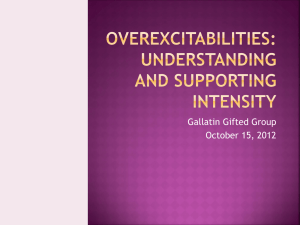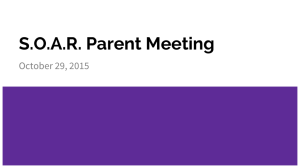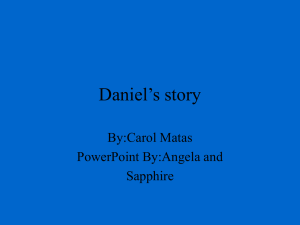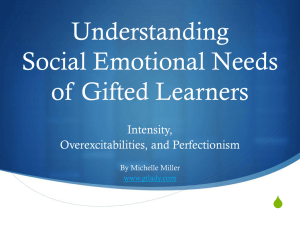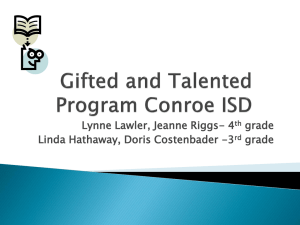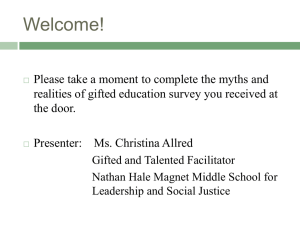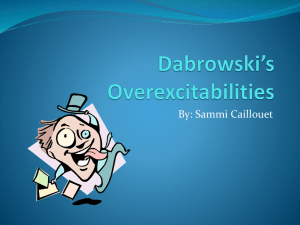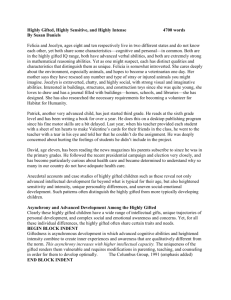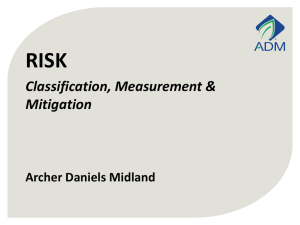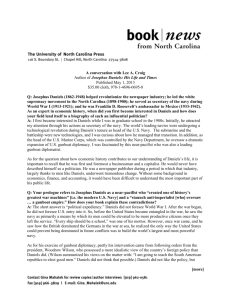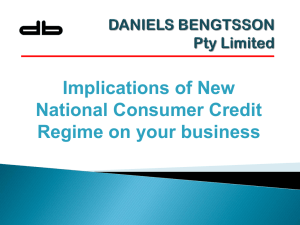Coping With Intensity
advertisement
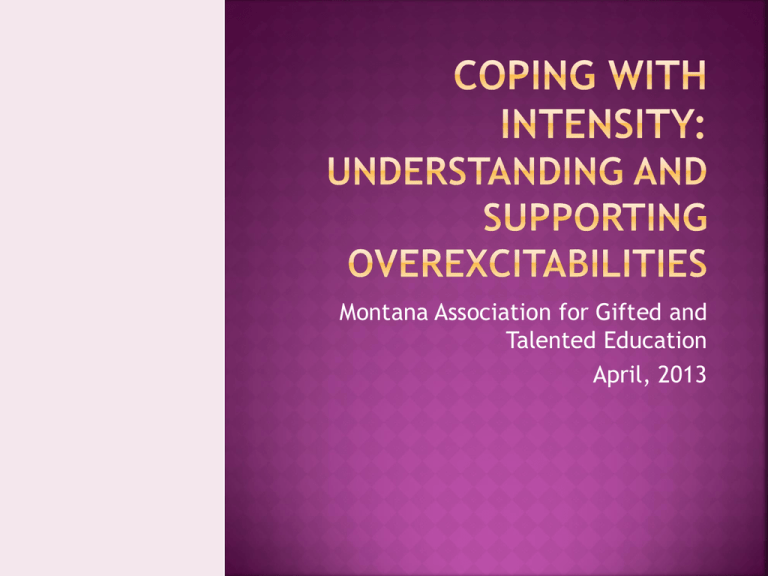
Montana Association for Gifted and Talented Education April, 2013 Welcome Wendy Morical, Bozeman Public Schools Session goals Establish a positive perspective Brief overview of Dabrowski’s theory Description of the overexcitibilities Strategies for supporting students “If just being smart is all there is to being gifted, then what’s the problem?” –Living with Intensity, Rivero “When I am listening to music my mind is not aware of anything else. I concentrate so heavily on music when I hear it that I cannot read efficiently and listen to music at the same time; I start to read in rhythm.” F, 18 “When I go into a class with a lot of enthusiasm and energy but the class is slow and boring I come out with two times as much energy ready to explode. Unfortunately I usually let this energy out by talking or goofing off in class, resulting in trouble.” M, 13 “..often my imagination takes over and I absolutely hear a voice or see someone running. I fear I’m going to be a menace on the roads when I get my license because of this tendency.” M, 15 “Frustration is the emotion that hits me the hardest. First it makes me mad, and since I can’t do anything to relieve the frustration when I’m mad I become depressed. When I’m frustrated I’m very irritable and sarcastic, and people learn in a hurry that they’d better leave me alone.” F, 16 “When I ‘get into’ a concept or theory, I am very happy and, sometimes, I almost lose my touch with the world and I ‘space off’.” M, 17 “I am always dissecting and analyzing which tends to ruin things, but I can’t help it. I have this need to understand. It verges on the obsessive side.” M, 17 “I feel like an alien.” “Gifted children take in information from the world around them; they react and respond more quickly and intensely than other children. They are stimulated both by what’s going on around them and by what moves them from within.” “Because they can be so greatly stimulated, and because they perceive and process things differently, gifted children are often misunderstood.” Living with Intensity, Daniels and Piechowski “ A child, rich in intensities and sensitivities, cannot be brought down to the “normal” range… Gifted children should not be pressed to “fit in” with all of the other children the same age. Rather, their capacity for intense experiencing is an asset that deserves to be understood and affirmed instead of squashed.” Living with Intensity, Daniels and Piechowski Theory of Positive Disintegration Kazimierz Dabrowski Viewed “superstimulatability” as potential for further growth Disintegration as a prelude to rebuilding Emotional development is result Development Potential – three factors Genetic traits: talents, specific abilities, general intelligence Overexcitibilities Capacity for self-determination, autonomy Five Overexcitabilities Innate tendencies to respond to various stimuli Experience of things may be deeper, more vivid, more acutely sensed “…greater capacity to be stimulated by and respond to external and internal stimuli. Overexcitability permeates a gifted person’s existence. Whether it’s music, language, physical sensing, kinesthetic activity, imagination, or something intellectual, an overexcitability orients and focuses [him]. Overexcitability gives energy to [his] intelligence and talents. It shapes [his] personality development.” Note: this quote, and the following overexcitability information come directly from Living With Intensity, edited by Daniels and Piechowski. Educate ourselves Accept Communicate Model Celebrate! “There is a vitality, a life force, a quickening that is translated through you into action, and there is only one of you in all time. This expression is unique, and if you block it, it will never exist through any other medium; and be lost. The world will not have it.” –Martha Graham, 1894 - 1991 Muscular activity associated with mental High energy level Not associated with athletic talent; due to asynchrony, that may even lag behind Movement facilitates learning May be verbally active as outlet “Enthusiastic, driven, competitive, acting out…” May be misdiagnosed as ADHD According to Daniels, these children need to hear: “You have wonderful enthusiasm and energy.” “I wish I had your energy.” “You put your whole body into your learning.” “Your intensity [drive] can help you do many things.” “Sometimes our bodies need to relax.” Strategies to support children Discuss positive aspects of OE. Plan for movement, avoid prolonged sitting. Involve child in physical tasks – errands? Teach that time out can be a choice, not punishment. Model and teach relaxation techniques. Help child notice signs of exhaustion or need for quiet time. “The spectacle of the sky overwhelms me. I’m overwhelmed when I see, in an immense sky, the crescent of the moon, or the sun.” –Joan Miró, 1893 – 1983 Heightened experience, both + and -, of seeing, smelling, tasting, touching, and hearing Often coupled with enhanced aesthetic appreciation Smell may evoke deep, positive emotional connection – or strong aversion Finicky eater – or gourmand Sounds can be soothing, uplifting – or highly irritating Sensitive to touch (labels, socks); may appreciate comfort objects longer Not exaggerating! Experience is real to them According to Daniels, these children need to hear: “You take such delight in beautiful sights, sounds, and feelings.” “You like ________, but I notice _______ bothers you.” “It seems you know what you like and what feels good to you.” “Sometimes, it’s good to try new things. Would you like to try________?” Strategies to support children Discuss positive aspects of OE. Provide environments that limit offensive stimuli. “Dwell in delight”! – make time to relish pleasures. Allow for child to control own living space as much as possible. Allow for prolonged attachments to objects. “My goal is simple. It is a complete understanding of the universe, why it is as it is and why it exists at all.” - Stephen Hawking, born 1942 Capacity and appetite for intellectual effort and stimulation Quest for understanding, truth Curiosity, “Why?” questions, fixations Mental multi tasking; thinking own “what if…” thoughts, also following along Requires access to rich, varied challenges May be coupled with perfectionism; focused, driven until “perfect” “Sometimes I feel like a big head rolling around” Profound focus may be misdiagnosed as “spectrum-y” According to Daniels, these children need to hear: “Your curiosity fuels your intelligence.” “You have wonderfully wide/deep interests.” “You have great potential to learn new things and make changes.” “You really stick to projects that interest you.” “You defend your ideas and are open to learning different information.” Strategies to support children Discuss positive aspects of OE. Listen to child’s ideas; schedule if necessary. Honor child’s desire to know and understand. Help children find answers to their own questions. Allow child to develop and pursue own projects. Help children develop goals and self-reflect on progress toward them. Seek opportunities for interaction with intellectual peers. “I dream, therefore I exist.” –August Strindberg, 1849-1912 Linked with creative production Heightened capacity for fantasy, less constrained by “the way it is.” Imaginary playmates common Imagination is source of retreat and delight Need to make thing more interesting can be challenging for teachers Capable of clear mental visualization Daydreams are vivid Great asset; wanes with teen/adult pressure to “grow up!” Can lead to mistaken ADD diagnosis According to Daniels, these children need to hear: “You have a rich imagination.” “You view the world in a unique way.” “You think of and tell great stories.” “You make the mundane extraordinary” (!) Strategies to support children Discuss positive aspects of OE. Support creative and imaginational expression. Provide opportunities for relaxation and free flow of ideas. Provide creative outlets. Help small children distinguish between imaginary and the real world, determine when imagination is appropriate. Have child use imagination to solve problems and cope with challenges. “I have found it easier to identify with the characters who verge upon hysteria, who were frightened of life, who were desperate to reach out to another person. But these seemingly fragile people are the strong people really.” - Tennessee Williams, 1911-1983 Most extensive, Dobrowski felt Not as prized as intellectual, creative Intense feelings that are manifested in extreme, complex, positive or negative ways Significant emotional response to “insignificant” stimuli Sometimes rooted in fears, anxieties: death loneliness love concern for others excruciating self-scrutiny Complexity of emotional response can paralyze or inhibit: how to act? Strongest bonds not always with peers Empathy for others, social action Can transcend own life and see overarching principles Sometimes somatic expressions: heart racing, sweating, stomach ache… Often accused of overreacting, drama Misdiagnosed as depression, anxiety, bipolar According to Daniels, these children need to hear: “You are sensitive to others’ feelings.” “You care very deeply and have deep feelings.” “You are very loyal to those you care about.” “You are wonderfully aware of joy/frustration/love/anger/sadness…” Strategies to support children Discuss positive aspects of OE. Accept feelings and the intensity with which they are expressed Develop a feeling vocabulary Learn listening and responding skills Teach children to anticipate emotional experiences, and rehearse responses, strategies Use journaling to record feelings Find activities that provide for expression of empathy and social concern “In ways both subtle and all-too-obvious, society tries to transform unique perceptions into commonplace, standard-issue behaviors, beliefs, perceptions, and attitudes. When this occurs, we chip away … the essence of giftedness.” – Parenting Gifted Kids, Delisle Ensure appropriate educational services Challenge, to stretch and develop strategies Organizational skills Work ethic Interaction with students of similar ability Use creativity, patience, trust Work within parameters of classroom Build into classroom routine Can be related to senses Music, white noise, quiet, noise cancelling headphones Dimmer switches Yoga, breathing, exercise Visualization Pilates balls, rocking All kids need boundaries Schedules Class meetings Advance warnings if change-averse Make sure they realize you’re talking to them (name, touch) Know signs and situations that may trigger distress or “emotional flooding” Come up with ways to communicate when a student is getting distressed Classroom seating choices Snacks, to eliminate “bipolar” reactive hypoglycemia Expect needs to change as they mature Acknowledge the emotions Brainstorm, record optimistic options Tag team – recruit helpers Take care of yourself Celebrate successes – and pass them on Daniels, Susan and Michael Piechowski, eds. Living with Intensity. Great Potential Press, 2009 Delisle, James. Parenting Gifted Kids: Tips for Raising Happy and Successful Children. Prufrock Press, 2006 Fonseca, Christine. Emotional Intensity in Gifted Students. Prufrock Press, 2011 Michels, Debbie and Teresa Rowlinson. Getting Over Excitabilities. SENG Vine, March 2011 (www.sengifted.org) Rivero, Lisa. The Smart Teen’s Guide to Living with Intensity. Great Potential Press, 2010 Webb, James et.al. Misdiagnosis and Dual Diagnoses of Gifted Children and Adults. Great Potential Press, 2005
